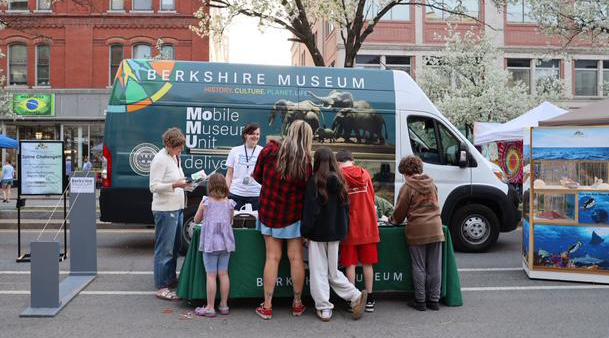Despite living in the picturesque backdrop once home to Herman Melville, Edith Wharton, W.E.B. Du Bois, and Norman Rockwell, students and senior citizens across the Berkshires are not always able to drive to Williamstown or Pittsfield to reach the area’s largest museums and exhibitions.
Enter the Berkshire Museum’s Mobile Museum Unit. A MoMU is a museum on wheels, carting exhibits through the mountains and hills to meet residents where they live, study, and work. Each MoMU is an inter-disciplinary narrative told through objects, graphics, and interactive displays. The units, shuttled around in courier vans, are designed in various sizes for display inside a classroom, library, reception area, or open community space.
Museums on wheels are not new, of course. The first units are thought to have originated in Ohio as part of the Traveling Trailside Museum of the Cleveland Museum of Natural History in 1947, or with the American Museum of Natural History in 1903. But the units found in the Berkshires are the first in the state and for nearly five years have depended on federal funding that will end in June.
A Biden-era program that helped support the mobile museums was not renewed under President Trump, officials said, and they are now searching for new ways to keep operating as they have. The mobile units have become key educational tools in a largely rural area, they said.
“It’s meant to be able to cross subjects so that any teacher can request it,’’ Sophia Holmes, the museum’s program director, said as she exited the van on a recent morning and walked toward Muddy Brook Regional Elementary School in Great Barrington. “Today we’re talking about bugs.’’
Holmes walked into the lobby and down to the first floor to check on one of the mobile units — a plexiglass-paneled display case on wheels filled with butterflies and insects — positioned outside kindergarten classrooms near another entrance to the school. “Our buses come in through here, so 80 percent of our school walks by it,’’ said Cynthia Carey, the school’s principal. “And 100 percent walk by it for lunch.’’
Then Holmes grabbed a small box of bugs and drawing materials and headed into her first of four classes for the day, in what would be a whirlwind three hours teaching children about how and why bugs use camouflage to navigate their worlds.
Schools, which sometimes cannot afford either financially or logistically to bus students out to the museum, have found the units and associated programming particularly welcome.
“It’s much more economical than traveling to a museum,’’ said Lynn Webster, a kindergarten teacher at Muddy Brook. “It really makes the kids curious and interested about the subject before [the museum personnel] come out.’’
The children may not have had a chance to see the bugs or learn about the different parts of an ant’s body outside of a textbook were it not for Holmes and the unit.
MoMUs in the Berkshires have resulted in a community-focused system that brings object-based learning to populations that might not be able to access the museum, as well as injecting a museum experience into unexpectedly commonplace situations. Recent mobile exhibitions have included topics such as the history of the Berkshire mountains, bugs, currency, mammal adaptations, and Mahican Indigenous heritage.
For the Berkshire Museum, it’s a return to its roots. In 1932, Laura Bragg, then the Berkshire Museum’s director and the first woman to run a publicly-funded museum in the United States, started toting around the mountainside communities what she called “Bragg Boxes,’’ relics and museum items similar to what the MoMUs offer.
Today displays and programs have reached more than 100 community and school locations across Western Massachusetts and New York State, extending beyond schools and school-age children.
MoMUs have appeared at assisted living facilities such as Kimball Farms in Lenox, at the YMCA in Pittsfield, or the Hancock Shaker Village.
“We put the Mohikin unit in since it gives more information about the Indigenous people of our region,’’ said Cindy Dickinson, director of education at Hancock Shaker Village, which installed a unit for its annual community day. “It’s our highest attendance day so we had many hundreds of people walk through it and every time I went in there to see how the museum staff were doing they were always busy, talking with others, really engaging.
Dickinson added, “They’re so nicely designed and thoughtfully presented and it seemed like a good fit for community day if they had one available.’’
The mobile units came in response to community need, not only because of the museum’s closure during construction, said Jesse Kowalski, the museum’s chief curator. Kowalski noted that, in addition to federal funding, the units received were also funded since 2021 through grants from the Massachusetts Cultural Council and the City of Pittsfield’s American Rescue Plan Program, and have cost roughly $175,000 since the program’s inception.
Christian Bianchi, the chief executive office and executive director of the Berkshire Family YMCA Pittsfield branch, has collaborated with the museum to host MoMUs at the downtown facility since last fall.
“Obviously it’s a great thing to have in a facility. It adds value to it immediately. It enhances an experience,’’ Bianchi said. “I think that my favorite part about it is our particular museum is very interested in sharing artwork and artifacts with the community on the scale that they do, doing it for free and also bringing in an educator. It just goes to show that collaboration can go toward enhancing the community.’’

